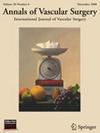动静脉瘘和移植物出血的急诊处理评价。
IF 1.6
4区 医学
Q3 PERIPHERAL VASCULAR DISEASE
引用次数: 0
摘要
目的:动静脉(AV)通路出血需要及时处理,但对这些事件后的短期和长期结果知之甚少。我们的目标是评估房室通道出血的应急管理及其结果。方法:回顾性分析2014-2022年在三级医疗中心因房室通道出血就诊的急诊科(ED)。对表现、严重程度、管理和结果进行评估。结果:66例患者符合纳入标准(平均年龄65.4岁,男性51.5%,黑人66.7%,西班牙裔18.2%)。通道类型包括肱头(34.8%)、肱基础(28.8%)、桡头(9.1%)、上肢AV移植物(16.7%)和下肢通道(16.7%)。大多数(78.8%)为插管后出血,18.2%为原发性溃疡。分诊紧急程度指数将ED分为危及生命(6.1%)、高危(31.8%)、紧急(60.6%)和半紧急(1.5%)。ED干预措施包括手压(37.9%)、缝线放置(25.8%)、局部止血(15.2%)、钳夹(13.6%)和止血带放置(1.5%)。大约一半(48.5%)的病例接受了血管外科手术。59%的患者从急诊室出院,41%的患者入院接受进一步治疗。15.2%的住院患者放置了隧道式透析导管。45.5%的患者需要对其通道进行干预(45.5%为开放,54.6%为血管内)。60%和40%的开放手术分别为通路修复和结扎。大多数(83.3%)接受瘘管造影的患者需要干预。在第90天,59%的人再次出现在急诊科,23%的人因相关原因再次入院。1年后,22.7%的患者需要建立新的房室通道。在六个月的随访中,只有45.5%的患者接受了外科手术。由一名通路外科医生在急诊科对患者进行评估导致相关再入院(25%对2.9%,P= 0.02)和1年干预(43.8%对17.7%,P= 0.02)减少,但在新建房室通路的需求方面没有差异(12.5%对2.9%,P= 0.19),两组6个月的随访都很低(34.4%对55.9%,P= 0.08)。结论:超过三分之一的房室通路出血表现为危及生命或高危程度。许多这样的患者在一年内需要新的房室通道。改善部门间的沟通和密切的患者随访仍然是改善结果的机会。本文章由计算机程序翻译,如有差异,请以英文原文为准。
Evaluating the Emergency Management of Arteriovenous Fistula and Graft Bleeds
Background
Arteriovenous (AV) access bleeding requires prompt management, but little is known about short- and long-term outcomes after these events. Our goal was to evaluate emergency management of AV access bleeds and their outcomes.
Methods
This is a retrospective analysis of emergency department (ED) visits for AV access bleeding at a tertiary care center between 2014 and 2022. Presentation, severity, management, and outcomes were evaluated.
Results
There were 66 patients that met the inclusion criteria (mean age was 65.4 years, 51.5% were male, 66.7% were Black, and 18.2% were Hispanic). Access types included brachiocephalic (34.8%), brachiobasilic (28.8%), radiocephalic (9.1%) fistulas, upper extremity AV grafts (16.7%), and lower extremity access (16.7%). The majority (78.8%) were postcannulation bleeds with 18.2% being primary ulcers. Triage emergency severity index classified ED presentation as life-threatening (6.1%), high-risk (31.8%), urgent (60.6%), and semi-urgent (1.5%). ED interventions included manual pressure (37.9%), suture placement (25.8%), topical hemostatic agents (15.2%), a clamp device (13.6%), and tourniquet placement (1.5%). Vascular surgery was consulted in approximately half (48.5%) of cases. In total, 59% of patients were discharged from the ED and 41% of patients were admitted to the hospital for further management. Tunneled dialysis catheters were placed in 15.2% of all hospitalized patients. In total, 45.5% of patients required an intervention on their access (45.5% open and 54.6% endovascular). In total, 60% and 40% of open operations were access revisions and ligations, respectively. The majority (83.3%) of patients undergoing fistulograms required an intervention. At 90 days, 59% of patients represented to the ED, with 23% of all readmissions for related causes. At 1 year, 22.7% of patients required new AV access creation. Six-month follow-up with an access surgeon was low at only 45.5% of patients. Having an access surgeon evaluate patients in the ED resulted in fewer related readmissions (25% vs. 2.9%, P = 0.02) and 1-year interventions (43.8% vs. 17.7%, P = 0.02), but there was no difference in the need for new AV access creations (12.5% vs. 2.9%, P = 0.19), and the 6-month follow-up in both groups was low (34.4% vs 55.9%, P = 0.08).
Conclusion
Over one-third of AV access bleeds presenting to the ED were of life-threatening or high-risk severity. Many such patients required a new AV access within 1 year. Improved interdepartmental communication and close patient follow-up remain opportunities for improved outcomes.
求助全文
通过发布文献求助,成功后即可免费获取论文全文。
去求助
来源期刊
CiteScore
3.00
自引率
13.30%
发文量
603
审稿时长
50 days
期刊介绍:
Annals of Vascular Surgery, published eight times a year, invites original manuscripts reporting clinical and experimental work in vascular surgery for peer review. Articles may be submitted for the following sections of the journal:
Clinical Research (reports of clinical series, new drug or medical device trials)
Basic Science Research (new investigations, experimental work)
Case Reports (reports on a limited series of patients)
General Reviews (scholarly review of the existing literature on a relevant topic)
Developments in Endovascular and Endoscopic Surgery
Selected Techniques (technical maneuvers)
Historical Notes (interesting vignettes from the early days of vascular surgery)
Editorials/Correspondence

 求助内容:
求助内容: 应助结果提醒方式:
应助结果提醒方式:


